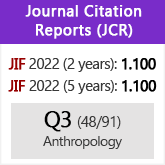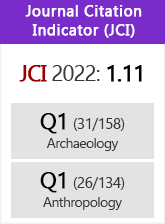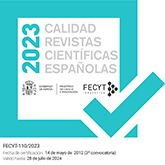Towards an Archaeology of Ethnicity
DOI:
https://doi.org/10.3989/tp.2011.11067Keywords:
Theoretical Archaeology, Culture History, Postmodernism, Iron AgeAbstract
In the last two decades the search for ethnicity through material culture has enjoyed a renewed boom in Archaeology. This process, which goes hand in hand with a reformulation of the concept in the Social Sciences, has led to a reconsideration of how the phenomenon itself is conceived as well as the possibilities of exploring it in groups from the past. This article attempts to make a contribution to the task of “rethinking” ethnicity in three steps: first a historiographic approach to the subject; second, a series of theoretical-methodological conclusions that will help in the ongoing task of constructing an “archaeology of ethnicity”; and, finally, a reflection on the period where these approaches have generated most interest: Protohistory.
Downloads
References
Almagro-Gorbea, M. y Ruiz Zapatero, G. (eds.) 1992: Paleoetnología de la Península Ibérica. Complutum Extra 2-3. Madrid.
Álvarez Martí-Aguilar, M. 2009: “Identidad y etnia en Tartesos”. En I. Sastre Prats (coord.): Arqueología Espacial 27: 79-111.
Álvarez-Sanchís, J. R. 1999: Los Vettones. Bibliotheca Archaeologica Hispana 1, Real Academia de la Historia. Madrid.
Amselle, J.-L. y M’bokolo, E. (eds.) 2005: Au coeur de l’ethnie: Ethnies, tribalisme et État en Afrique. Éditions La Découverte. París.
Anderson, B. 1983: Imagined communities: Reflections on the origins and spread of nationalism. Verso. Londres.
Anthony, D. W. 1990: “Migration in Archeology: The Baby and the Bathwater”. American Anthropologist 92 (4): 895-914. http://dx.doi.org/10.1525/aa.1990.92.4.02a00030
Arnold, B. 1990: “The past as propaganda: totalitarian archaeology in Nazi Germany”. Antiquity 64: 464-478.
Arnold, B. 1992: “The past as propaganda: How Hitler’s archaeologists distorted European prehistory to justify racist and territorial goals”. Archaeology July/August: 30-37.
Arnold, B. 2006: “Arierdämmerung: race and archaeology in Nazi Germany”. World Archaeology 38 (1): 8-31. http://dx.doi.org/10.1080/00438240500509744
Banks, M. 1996: Ethnicity: Anthropological Constructions. Routledge. Londres, Nueva York. http://dx.doi.org/10.4324/9780203417935
Barth, F. (ed.) 1969: Ethnic Groups and Boundaries. The Social Organization of Culture Difference. Little Brown. Boston.
Beltrán Lloris, F. 2004: “Nos Celtis genitos et ex Hiberis. Apuntes sobre las identidades colectivas en Celtiberia”. En G. Cruz Andreotti y B. Mora Serrano (eds.): Identidades étnicas-Identidades políticas en el mundo prerromano hispano. Servicio de Publicaciones de la Universidad de Málaga. Málaga: 87-145.
Bentley, G. C. 1987: “Ethnicity and Practice”. Comparative Studies in Society and History 29 (1): 24- 55. http://dx.doi.org/10.1017/S001041750001433X
Binford, L. R. 1962: “Archaeology as Anthropology”. American Antiquity 28: 217-225. http://dx.doi.org/10.2307/278380
Binford, L. R. 1965: “Archaeological systematics and the study of cultural process”. American Antiquity 31: 203-210. http://dx.doi.org/10.2307/2693985
Boissinot, P. 1998: “Que faire de l’identité avec les seules méthodes de l’archéologie?”. En A. D’Anna y D. Binder (eds.): Production et identité culturelle: actualité de la recherche. Rencontres meridionales de Préhistoire récente (Arles, 1996). Editions APDCA. Antibes: 17-26.
Bosch Gimpera, P. 1932: Etnologia de la Península Ibèrica. Alpha. Barcelona.
Bourdieu, P. 1972: Esquisse d’une théorie de la pratique. Droz. Ginebra, París.
Bourdieu, P. 1980: Le sens pratique. Minuit. París.
Brather, S. 2004: Ethnische Interpretationen in der frühgeschichtlichen Archäologie. Geschichte, Grundlagen und Alternativen. RGA Ergänzungsbd. 42, Walter de Gruyter. Berlín, Nueva York.
Brubaker, R. 2004: Ethnicity without Groups. Harvard University Press. Cambridge (Massachusetts), Londres.
Burillo, F. 2007: Los Celtíberos. Etnias y Estados. Crítica. Barcelona.
Cardete del Olmo, M.ª C. 2006: “La etnicidad como un arma ideológico-religiosa en la Antigua Grecia: el caso del Monte Liceo”. Spal 15: 189-203.
Cardete del Olmo, M.ª C. 2009: “Construcciones Identitarias en el mundo antiguo: arqueología y fuentes literarias. El caso de la Sicilia Griega”. En I. Sastre Prats (coord.): Arqueología Espacial 27: 29-46.
Clarke, D. L. 1968: Analytical Archaeology. Methuen. Londres.
Cohen, A. P. 1985: The Symbolic Construction of Community. Ellis Horwood. Londres, Nueva York. Collis, J. 2003: The Celts. Origins, Myths and Inventions. Tempus. Stroud.
Collis, J. 2007: “The polities of Gaul, Britain, and Ireland in the Late Iron Age”. En C. Haselgrove y T. Moore (eds.): The Later Iron Age in Britain and Beyond. Oxbow Books. Oxford: 523-528.
Cornell, T. y Lomas, K. (eds.) 1997: Gender and Ethnicity in Ancient Italy. Accordia Specialist Studies on Italy 6. Londres.
Cruz Andreotti, G. y Mora Serrano, B. (eds.) 2004: Identidades étnicas-Identidades políticas en el mundo prerromano hispano. Servicio de Publicaciones de la Universidad de Málaga. Málaga.
Champion, T. C. 1985: “Written sources and the study of the European Iron Age”. En T. C. Champion y J. V. S. Megaw (eds.): Settlement and Society. Aspects of West European Prehistory in the first Millenium B.C. Leicester University Press. Leicester: 9- 22.
Childe, V. G. 1929: The Danube in Prehistory. Clarendon Press. Oxford.
Davis, K. 2008: “Intersectionality as buzzword: a sociology of science perspective on what makes feminist theory successful”. Feminist Theory 9 (1): 67-86. http://dx.doi.org/10.1177/1464700108086364
Derks, T. y Roymans, N. 2009: “Introduction”. En T. Derks y N. Roymans (eds.): Ethnic Constructs in Antiquity: The Role of Power and Tradition. Amsterdam University Press. Amsterdam: 1-10.
Díaz-Andreu, M. 1998: “Ethnicity and Iberians: the archaeological crossroads between perception and material culture”. European Journal of Archaeology 1 (2): 199-218. http://dx.doi.org/10.1177/146195719800100204
Díaz-Andreu, M.; Lucy, S.; Babic, S. y Edwards, D. N. 2005: The Archaeology of Identity. Approaches to gender, age, status, ethnicity and religion. Routledge. Londres, Nueva York.
Díaz-Andreu, M. y Smith, A. D. (eds.) 2001: Nationalism and Archaeology. Blackwell. Londres.
Díaz Santana, B. 2003: “Los celtas. Identidad, etnicidad y arqueología”. Spal 12: 299-316.
Eriksen, T. H. 1993: Ethnicity and Nationalism: Anthropological Perspectives. Pluto Press. Londres.
Fenton, S. 2003: Ethnicity. Polity Press. Cambridge. Fernández Götz, M. A. 2008: La construcción arqueológica de la etnicidad. Serie Keltia 42. Editorial Toxosoutos. Noia.
Fernández Götz, M. A. 2009a: “Gustaf Kossinna: análisis crítico de una figura paradigmática de la arqueología europea”. Arqueoweb. Revista sobre Arqueología en Internet 11 http://www.ucm.es/info/arqueoweb/numero11/conjunto11.htm consulta 26-VI-2011.
Fernández Götz, M. A. 2009b: “La etnicidad desde una perspectiva arqueológica: propuestas teóricometodológicas”. Espacio, Tiempo y Forma, Serie II, Historia Antigua 22: 187-199.
García Fernández, F. J. 2007: “Etnología y etnias de la Turdetania en época prerromana”. Cuadernos de Prehistoria y Arqueología Universidad Autónoma de Madrid 33: 117-143.
Gassowski, J. 2003: “Is Ethnicity Tangible?”. En M. Hardt, Ch. Lübke y D. Schorkowitz (eds.): Inventing the Pasts in North Central Europe. The National Perception of Early Medieval History and Archaeology. Gesellschaften und Staaten im Epochenwandel 9, Peter Lang. Frankfurt am Main: 9-17.
Gehrke, H.-J. 2000: “Mythos, Geschichte und kollektive Identität. Antike exempla und ihr Nachleben”. En D. Dahlmann y W. Potthoff (eds.): Mythen, Symbole und Rituale. Die Geschichtsmächtigkeit der Zeichen in Südosteuropa im 19. und 20. Jahrhundert. Heidelberger Publikationen zur Slavistik 14, Peter Lang. Frankfurt am Main: 1-24.
Giddens, A. 1984: The Constitution of Society: outline of the theory of structuration. Polity Press. Cambridge.
Glazer, N. y Moynihan, D. P. 1975: “Introduction”. En N. Glazer y D. P. Moynihan (eds.): Ethnicity: theory and experience. Harvard University Press. Cambridge, Massachusets: 1-26.
González García, F. J. 2007: “Celtismo e historiografía en Galicia: en busca de los celtas perdidos”. En F. J.
González García (coord.): Los pueblos de la Galicia céltica. Akal. Madrid: 9-130.
González Ruibal, A. 2003: La experiencia del Otro. Una introducción a la etnoarqueología. Akal. Madrid. González Ruibal, A. 2006-07: Galaicos. Poder y comunidad en el Noroeste de la Península Ibérica. Brigantium 18/19. A Coruña.
González Ruibal, A. (ed.) 2007: “Arqueología Simétrica: Un giro teórico sin revolución paradigmática”. Complutum 18: 283-319.
Grau Mira, I. 2005: “Espacios étnicos y políticos en el área oriental de Iberia”. Complutum 16: 105-123.
Graves-Brown, P.; Jones, S. y Gamble, C. (eds.) 1996: Cultural Identity and Archaeology. The Construction of European Communities. Routledge. Londres, Nueva York.
Greco, E. (ed.) 2002: Gli Achei e l’identita etnica degli Achei d’Occidente: Atti del Convegno Internazionale di Studi. Fondazione Paestum. Atenas.
Hall, J. M. 1997: Ethnic identity in Greek antiquity. Cambridge University Press. Cambridge. http://dx.doi.org/10.1017/CBO9780511605642
Hall, J. M. 1998: “Discourse and Praxis: Ethnicity and Culture in Ancient Greece”. Cambridge Archaeological Journal 8 (2): 266-269.
Hall, J. M. 2002: Hellenicity. Between ethnicity and culture. The University of Chicago Press. Chicago/ Londres.
Herbert, S. 2003: “Excavating Ethnic Strata: The Search for Hellenistic Phoenicians in the Upper Galilee of Israel”. En S. Kane (ed.): The Politics of Archaeology and Identity in a Global Context. Archaeological Institute of America. Boston: 101- 113.
Hernando Gonzalo, A. 2002: Arqueología de la Identidad. Akal. Madrid.
Hobsbawm, E. y Ranger, T. (eds.) 1983: The Invention of Tradition. Cambridge University Press. Cambridge. Hodder, I. 1982: Symbols in action. Ethnoarchaeological studies of material culture. Cambridge University Press. Cambridge.
Hutchinson, J. y Smith, A. D. 1996: “Introduction”. En J. Hutchinson y A. D. Smith (eds.): Ethnicity. Oxford University Press. Oxford, Nueva York: 3- 14.
Insoll, T. (ed.) 2007: The archaeology of identities: a reader. Routledge. Londres, Nueva York.
James, S. 1999: The Atlantic Celts. Ancient People or Modern Invention? British Museum Press. Londres. Jenkins, R. 1997: Rethinking Ethnicity: Arguments and Explorations. Sage. Londres.
Jenkins, R. 2002: “Imagined but not Imaginary: Ethnicity and Nationalism in the Modern World”. En J. MacClancy (ed.): Exotic no More. Anthropology. The University of Chicago Press. Chicago: 114- 128.
Jenkins, R. 2004: Social Identity. Routledge. Londres, Nueva York.
Jiménez Díez, A. 2008: Imagines Hibridae. Una aproximación postcolonialista al estudio de las necrópolis de la Bética. Anejos de Archivo Español de Arqueología XLIII. Madrid.
Jones, S. 1997: The Archaeology of Ethnicity. Constructing identities in the past and present. Routledge. Londres, Nueva York.
Jones, S. 1998: “Ethnic Identity as Discursive Strategy: the Case of the Ancient Greeks”. Cambridge Archaeological Journal 8 (2): 271-273.
Jones, M. 2006: “Archaeology and the Genetic Revolution”. En J. L. Bintliff (ed.): A Companion to Archaeology. Blackwell. Oxford: 39-51.
Knipper, C. 2004: “Die Strontiumisotopenanalyse: eine naturwissenschaftliche Methode zur Erfassung von Mobilität in der Ur- und Frühgeschichte”. Jahrbuch des Römisch-Germanischen Zentralmuseums Mainz 51: 589-685.
Kossinna, G. 1911: Die Herkunft der Germanen. Zur Methode der Siedlungsarchäologie. Mannus-Bibliothek 6. Würzburg.
Krämer, W. 1982: “Graffiti auf Spätlatènekeramik aus Manching”. Germania 60 (2): 489-499.
Krausse, D. 2006: “The Prehistory of the Celts in South-West Germany. Centralisation processes and Celtic ethnogenesis in the heart of Europe”. En D. Vitali (ed.): Celtes et Gaulois, l’Archéologie face à l’Histoire. 2: La Préhistoire des Celtes. Actes de la table ronde de Bologne-Monterenzio, 28-29 mai 2005. Centre archéologique européen, collection Bibracte 12/2. Glux-en-Glenne: 131-142.
Kristiansen, K. 2001: Europa antes de la Historia. Península. Barcelona.
Larick, R. 1986: “Age grading and ethnicity in the style of Loikop (Samburu) spears”. World Archaeology 18 (2): 269-283. http://dx.doi.org/10.1080/00438243.1986.9980003
Legendre, J.-P.; Olivier, L. y Schnitzler, B. (eds.) 2007: L’archéologie nazie en Europe de l’Ouest. Infolio. París.
Lemonnier, P. 1986: “The study of material culture today: toward an anthropology of technical systems”. Journal of Anthropological Archaeology 5: 147-186. http://dx.doi.org/10.1016/0278-4165(86)90012-7
Lomas, K. (ed.) 2004: Greek Identity in the western Mediterranean. Papers in honour of Brian Shefton. Brill. Leiden.
Lorrio, A. 2005: Los Celtíberos. Bibliotheca Archaeologica Hispana 25, Real Academia de la Historia. Madrid.
Lund, A. 1998: Die ersten Germanen. Ethnizität und Ethnogenese. C. Winter. Heidelberg.
Mac Sweeney, N. 2009: “Beyond Ethnicity: The Overlooked Diversity of Group Identities”. Journal of Mediterranean Archaeology 22 (1): 101-126.
Malkin, I. (ed.) 2001: Ancient Perceptions of Greek Ethnicity. Harvard University Press. Cambridge/ Londres.
Meinander, C. F. 1981: “The concept of culture in European archaeological literature”. En G. Daniel (ed.): Towards a history of archaeology. Thames and Hudson. Londres: 100-111.
Miller, D. (ed.) 2005: Materiality. Duke University Press. Durham.
Mirza, M. N. y Dungworth, D. B. 1995: “The potential misuse of genetic analyses and the social construction of ‘race’ and ‘ethnicity’”. Oxford Journal of Archaeology 14 (3): 345-354. http://dx.doi.org/10.1111/j.1468-0092.1995.tb00068.x
Moerman, M. 1965: “Ethnic Identification in a Complex Civilization: Who are the Lue?”. American Anthropologist 67 (5): 1215-1230. http://dx.doi.org/10.1525/aa.1965.67.5.02a00070
Moscati, L. (ed.) 2002: Identità e prassi storica nel Mediterraneo Greco. Edizioni ET. Milán.
Olsen, B. y Kobylinski, Z. 1991: “Ethnicity in anthropological and archaeological research: a Norwegian- Polish perspective”. Archaeologia Polona 29: 5-27.
Plácido Suárez, D. 2009: “Los pueblos prerromanos y sus observadores”. En I. Sastre Prats (coord.): Arqueología Espacial 27: 47-61.
Pollex, A.; Sikora, P. y Alt, K. W. 2005: “Zum Nachweis von Fremden im archäologischen Befund”.,Ethnographisch-Archäologische Zeitschrift 46 (2): 279-294.
Prien, R. 2005: Archäologie und Migration. Vergleichende Studien zur archäologischen Nachweisbarkeit von Wanderungsbewegungen. Habelt. Bonn.
Ramírez Goicoechea, E. 2007: Etnicidad, identidad y migraciones. Ed. Universitaria Ramón Areces. Madrid.
Renfrew, C. 1990: Arqueología y Lenguaje. La cuestión de los orígenes indoeuropeos. Crítica. Barcelona. Reycraft, R. M. (ed.) 2005: Us and them: Archaeology and Ethnicity in the Andes. Cotsen Institute of Archaeology. UCLA.
Rieckhoff, S. y Sommer, U. (eds.) 2007: Auf der Suche nach Identitäten: Volk - Stamm - Kultur - Ethnos. Internationale Tagung der Universität Leipzig vom 8.-9. Dezember 2000. British Archaeological Reports International Series 1705, Archaeopress. Oxford.
Roymans, N. 2004: Ethnic Identity and Imperial Power: The Batavians in the early Roman Empire. Amsterdam University Press. Amsterdam. http://dx.doi.org/10.5117/9789053567050
Ruby, P. 2006: “Peuples, fictions? Ethnicité, identité ethnique et sociétés anciennes”. Revue des Études Anciennes 108 (1): 25-60.
Ruiz, A. y Molinos, M. 1993: Los Iberos. Análisis arqueológico de un proceso histórico. Crítica. Barcelona. Ruiz Zapatero, G. 2001: “¿Quiénes fueron los celtas? Disipando la niebla: mitología de un collage histórico”. En M. Almagro-Gorbea, M.ª Mariné y J. R. Álvarez-Sanchís (eds.): Celtas y Vettones. Diputación Provincial de Ávila. Ávila: 72-91.
Ruiz Zapatero, G. (ed.) 2005: “Un círculo de lectores: Miradas sobre los celtas del NO. de la Península Ibérica”. Complutum 16: 151-208.
Ruiz Zapatero, G. 2009: “Etnicidad protohistórica y arqueológica: límites y posibilidades”. En I. Sastre Prats (coord.): Arqueología Espacial 27: 13-27. Ruiz Zapatero, G. y Álvarez-Sanchís, J. R. 2002: “Etnicidad y Arqueología: tras la identidad de los Vettones”. Spal 11: 253-275.
Sastre Prats, I. (coord.) 2009: Arqueología Espacial 27. Scott, J. C. 2009: The Art of Not Being Governed. An Anarchist History of Upland Southeast Asia. Yale University Press. New Haven/Londres.
Shennan, S. J. 1989: “Introduction: archaeological approaches to cultural identity”. En S. J.
Shennan (ed.): Archaeological Approaches to Cultural Identity. Unwin Hyman. Londres: 1-32.
Siapkas, J. 2003: Heterological ethnicity: Conceptualizing identities in ancient Greece. Acta Universitatis Upsaliensis. Uppsala.
Siegmund, F. 2000: Alemannen und Franken. Archäologische Studie zu Ethnien und ihren Siedlungsräumen in der Merowingerzeit. RGA Ergänzungsbd. 23, Walter de Gruyter. Berlín, Nueva York.
Sklenár, K. 1983: Archaeology in Central Europe: the First 500 Years. Leicester University Press, St. Martin’s Press. Nueva York.
Smith, A. D. 2008: The Cultural Foundations of Nations. Hierarchy, Covenant, and Republic. Blackwell. Oxford.
Smith, S. T. 2003: Wretched Kush: Ethnic identities and boundaries in Egypt’s Nubian Empire. Routledge. Londres, Nueva York.
Smolla, G. 1979-80: “Das Kossinna-Syndrom”. Fundberichte aus Hessen 19/20: 1-9.
Sommer, U. 2007: “Archäologische Kulturen als imaginäre Gemeinschaften”. En S. Rieckhoff y U. Sommer (eds.): Auf der Suche nach Identitäten: Volk - Stamm - KulturEthnos. Internationale Tagung der Universität Leipzig vom 8.-9. Dezember 2000. British Archaeological Reports International Series 1705, Archaeopress. Oxford: 59-78.
Song, M. 2003: Choosing Ethnic Identity. Polity Press. Cambridge.
Veit, U. 1989: “Ethnic concepts in German Prehistory: A case study on the relationships between cultural identity and archaeological objectivity”. En S. J. Shennan (ed.): Archaeological Approaches to Cultural Identity. Unwin Hyman. Londres: 35-56.
Verkuyten, M. 2004: The Social Psychology of Ethnic Identity. Psychology Press. Hove/Nueva York. Vitali, D. y Kaenel, G. 2000: “Un Helvète chez les Etrusques vers 300 av. J.-C.”. Archäologie der Schweiz 23 (3): 115-122.
Vives-Ferrándiz Sánchez, J. 2007: “Colonial encounters and the negotiation of identities in south-east Iberia”. En S. Antoniadou y A. Pace (eds.): Mediterranean Crossroads. Selected Papers of the International Conference, Athens, 10-13th May 2005. Pierides Foundation. Atenas: 537-562.
Voss, B. L. 2008: The Archaeology of Ethnogenesis: Race and Sexuality in Colonial San Francisco. University of California Press. Berkeley.
Weber, M. 1922: Wirtschaft und Gesellschaft. Grundriss der verstehenden Soziologie. Mohr. Tubinga. Wells, P. S. 1998: “Identity and Material Culture in the Later Prehistory of Central Europe”. Journal of Archaeological Research 6 (3): 239-298.
Wells, P. S. 2001: Beyond Celts, Germans and Scythians: Archaeology and Identity in Iron Age Europe. Duckworth. Londres.
Wiessner, P. 1983: “Style and Social Information in Kalahari San Projectile Points”. American Antiquity 48 (2): 253-276. http://dx.doi.org/10.2307/280450
Woolf, G. 2009: “Cruptorix and his kind. Talking ethnicity on the middle ground”. En T. Derks y N. Roymans (eds.): Ethnic Constructs in Antiquity: The Role of Power and Tradition. Amsterdam University Press. Amsterdam: 207-217.
Wulff, F. y Álvarez Martí-Aguilar, M. (eds.) 2009: Identidades, culturas y territorios en la Andalucía prerromana. Universidad de Málaga. Málaga.
Downloads
Published
How to Cite
Issue
Section
License
Copyright (c) 2011 Consejo Superior de Investigaciones Científicas (CSIC)

This work is licensed under a Creative Commons Attribution 4.0 International License.
© CSIC. Manuscripts published in both the printed and online versions of this Journal are the property of Consejo Superior de Investigaciones Científicas, and quoting this source is a requirement for any partial or full reproduction.All contents of this electronic edition, except where otherwise noted, are distributed under a “Creative Commons Attribution 4.0 International” (CC BY 4.0) License. You may read here the basic information and the legal text of the license. The indication of the CC BY 4.0 License must be expressly stated in this way when necessary.
Self-archiving in repositories, personal webpages or similar, of any version other than the published by the Editor, is not allowed.

















